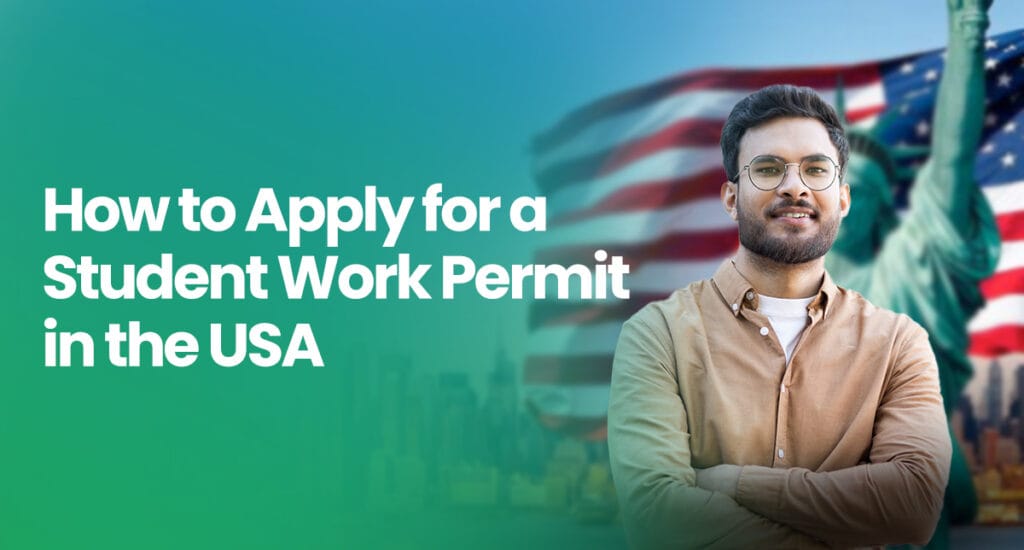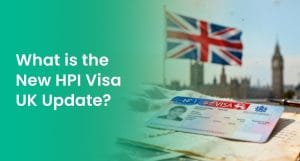Blog

14 May 2025
How to Apply for a Student Work Permit in the USA
Here is a comprehensive guide for international students who are planning to apply for a student work permit in the USA. The opportunity for international students studying in the United States to work while pursuing academic goals is both exciting and practical.
A student work permit, commonly referred to as an Employment Authorization Document (EAD), enables F-1 and M-1 visa holders to get significant professional experience, supplement their income, and integrate themselves into the American workforce. However, negotiating with the complex U.S. immigration system to obtain work authorization can be difficult. This guide demystifies the process by providing a straightforward, step-by-step method on how to apply for a Student Work Permit in the USA, a complete guide with tips to ensure success.
Work Authorization for International Students
The United States provides a variety of work authorization alternatives for international students, principally through the F-1 and M-1 visa categories. The F-1 visa is the most prevalent, designed for academic students pursuing full-time school, while the M-1 visa is for those enrolling in vocational or non-academic programs. Both sorts of visas allow you to work, but the regulations are strict and compliance is not optional. Unauthorized employment might endanger your visa status, so knowing your choices is crucial.
The primary avenues for work authorization include:
On-Campus Employment: F-1 students can work on campus without a separate work permit, provided they are enrolled full-time and maintain valid status.
Curricular Practical Training: This allows F-1 students to work off-campus roles integral to their academic program, such as internships or co-ops, typically during their studies.
Optional Practical Training: A temporary employment opportunity directly related to an F-1 student’s major, available before or after graduation. OPT is the most popular choice for post-study work.
Economic Hardship Employment: F-1 students facing serious, unexpected financial issues may apply for off-campus work authorization.
M-1 Practical Training: M-1 students are permitted to participate in practical training after completing their studies, although this requires prior authorization.
Each option has distinct eligibility criteria, application processes, and timetables, so it is important to consult your Designated School Official early in the process.
How to apply for a Student Work Permit
Step-by-Step Guide to Applying for a Student Work Permit
Step 1: Confirm Your Eligibility
Eligibility hinges on your visa type and academic status. For F-1 students pursuing OPT, you must:
Enroll full-time in a Student and Exchange Visitor Program (SEVP)-certified institution for at least one academic year.
Ensure the employment is directly related to your major.
Have a valid F-1 status and be in good academic standing.
For CPT, the employment must be a necessary component of your program, whereas economic hardship applications require documentation of unanticipated financial hardships. M-1 students are eligible for practical training only after the completion of their program. Always verify your eligibility with your Designated School Official (DSO), who oversees your Student and Exchange Visitor Information System (SEVIS) record.
Step 2: Consult Your Designated School Official
Your DSO is your primary ally in navigating work authorization. Schedule a meeting to discuss your goals whether it’s CPT, OPT, or economic hardship employment. The DSO will:
Confirm your eligibility and advise on the best option.
Update your SEVIS record with a recommendation for work authorization.
Issue an updated Form I-20, “Certificate of Eligibility for Nonimmigrant Student Status,” which is required for your application.
For OPT, the DSO’s recommendation must be entered in SEVIS before you file with U.S. Citizenship and Immigration Services. Timing is critical: for post-completion OPT, apply within 60 days of your DSO’s recommendation and no later than 60 days after graduation.
Step 3: Prepare Your Application
To apply for a Student Work Permit in the US, you need to submit Form I-765, “Application for Employment Authorization.” Prepare the following documents:
Form I-765: Complete it properly, specifying a suitable eligible category.
Form I-20: Include the amended form endorsed by your DSO.
Passport and Visa: Please provide photocopies of the biographical page of your passport as well as your F-1 or M-1 visa.
I-94 Get this information from the US Customs and Border Protection website.
photographs: Include two passport photographs.
Filing Fees: As of 2025, the charge for Form I-765 is roughly $520; however, fee exemptions may be available in some instances. Check the USCIS website for updates.
Supporting documents: For economic hardship applications, add a cover letter outlining your financial position and supporting proof.
Double-check your application for completeness, as errors can delay processing.
Step 4: Submit Your Application to USCIS
You can file Form I-765 online via the USCIS website or by mail to the appropriate USCIS Lockbox. Use a trackable delivery service like UPS or FedEx to ensure your application arrives safely. USCIS processing dates usually vary between 90 and 120 days, so apply early, particularly for OPT, which cannot begin until you get your EAD card.
Step 5: Attend a Biometrics Appointment (if required)
USCIS may schedule a biometrics appointment to collect your fingerprints, photo, and signature. Attend promptly, bringing your appointment notice, passport, and I-20.
Step 6: Receive Your Employment Authorization Document
Once USCIS approves your application, they will mail you the EAD card specifying the dates you’re authorized to work. Do not start employ until you receive this card and the start date is effective. For OPT, the EAD typically permits up to 12 months of work, with a 24-month extension offered for STEM graduates employed by E-Verify employers.
Key Tips for Success
- Start Early: USCIS processing interruptions are common, so OPT applications must be scheduled properly. Post-completion OPT can be submitted up to 90 days before graduation.
- Stay Compliant: Work only within the scope of your authorization. Unauthorized employment can result in visa termination and removal from the U.S.
- Leverage Resources: The International Student Office at your university, career services, and websites such as Study in the States and USCIS.gov provide helpful guidance.
- Network Strategically: While OPT doesn’t require a job offer to apply, securing employment related to your major boosts your application and career prospects. Make the most of career fairs and professional platforms like LinkedIn to connect with opportunities
- Plan for the Future: OPT can be a stepping stone to an H-1B visa or other work authorization. Consult an immigration attorney to explore the best path forward.
Why It Matters
Securing a student work permit is more than just a bureaucratic hurdle; it is a pathway to professional development and cultural immersion. Whether you’re interning at a software startup, performing research, or working on campus, these opportunities help you polish your abilities, build your resume, and connect with the US employment market. For many, it is the initial step towards a global career.
However, the process requires dedication and patience. Immigration rules are strict, and mistakes can have serious consequences. That’s why it’s crucial to understand how to apply for a student work permit in the US.
Prepare in advance, stay in touch with your DSO, and keep yourself informed. These steps will help you navigate the system with confidence.
At MWT Study Abroad, we guide students in choosing the right course that leads to in-demand jobs. If you need help, feel free to reach out to us.
Obtaining a student work permit is a major breakthrough it bridges the gap between classroom learning and real-world experience, opening doors to unrivaled growth and opportunity. With the right guidance, you’ll be well-equipped to tackle the process with clarity and diligence. So, take the first step: schedule an appointment with your DSO, organize your documents, and take that first step into a journey where education meets experience.
We hope this has helped you take the necessary steps to apply for a Student Work Permit in the USA.
Also check: USA H-1B vs UK Skilled Worker Visa: Which is Easier in 2025?





